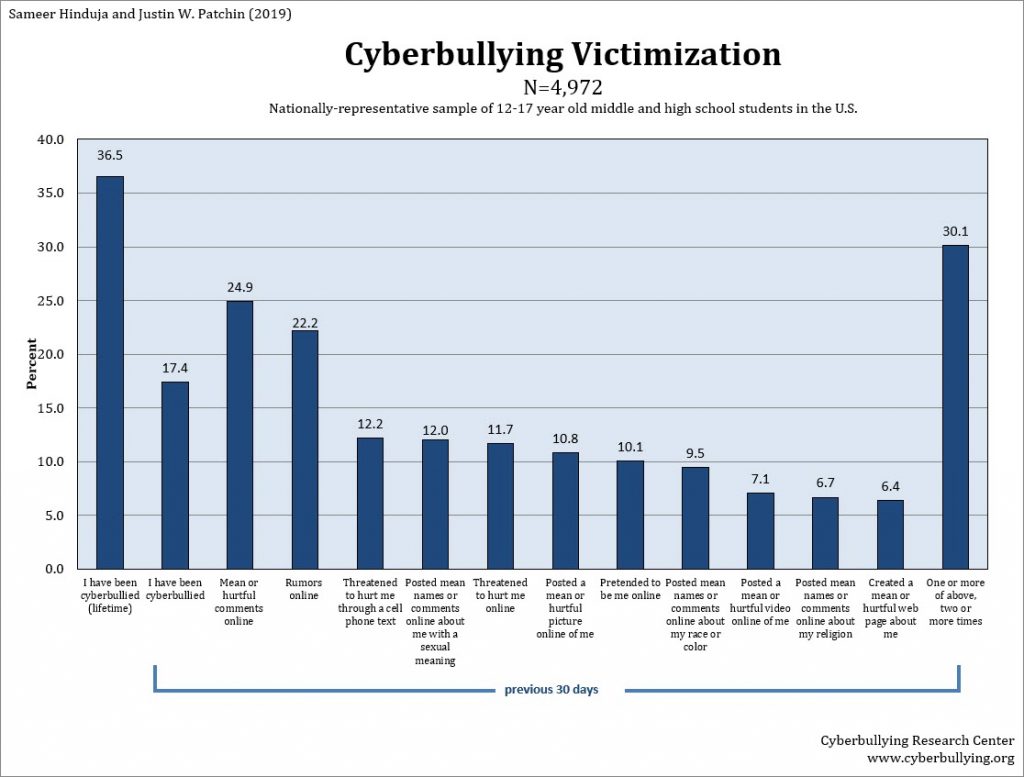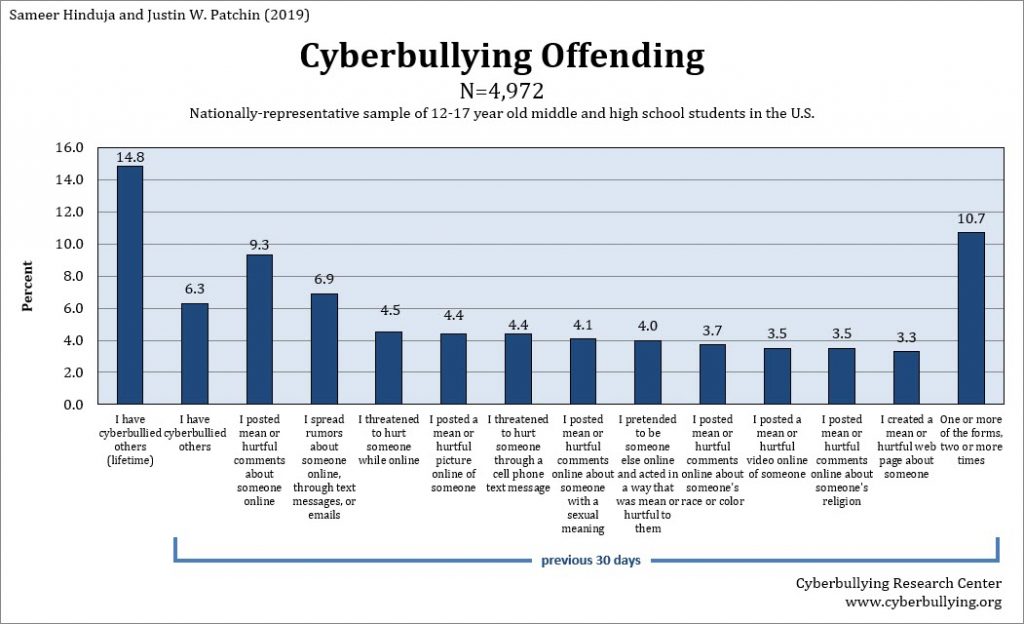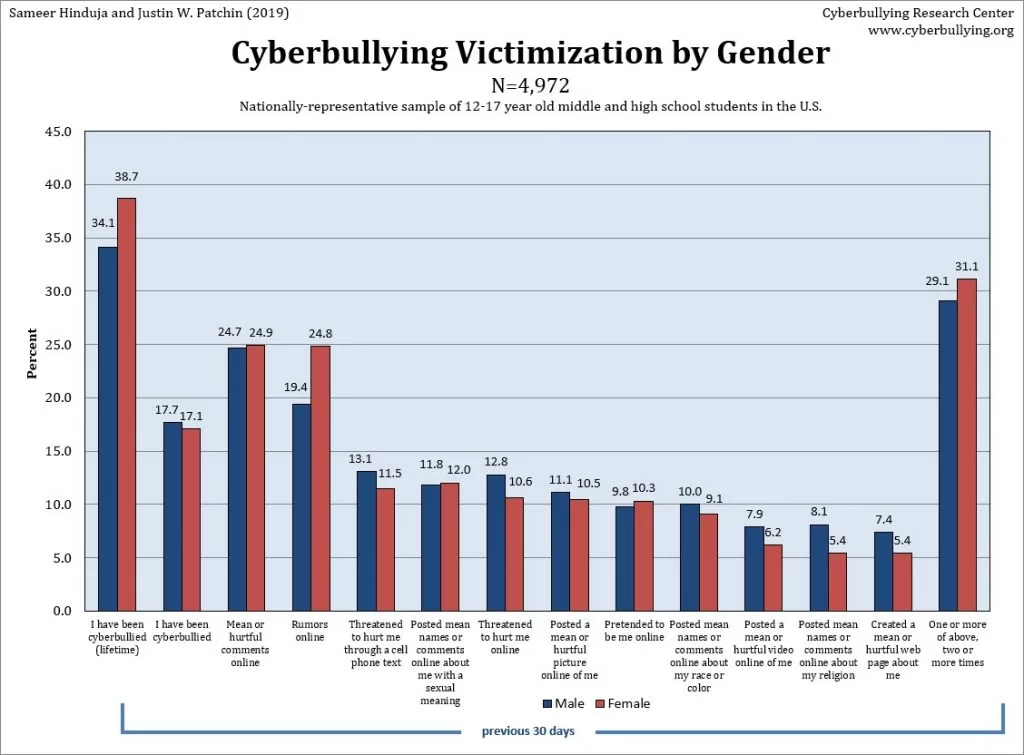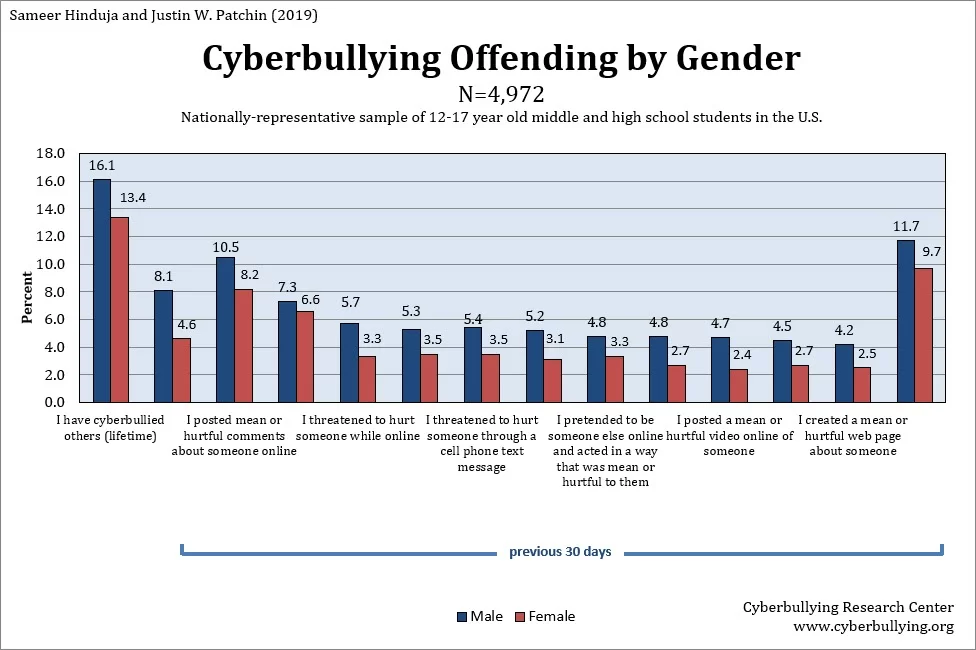
Presents data on cyberbullying from a 2019 national survey of middle and high school students in the United States.
This study surveyed a nationally-representative sample of 4,972 middle and high school students between the ages of 12 and 17 in the United States. Data were collected in April of 2019. Click on the thumbnail images to enlarge.




Cyberbullying Data: Victimization
We define cyberbullying as: “Cyberbullying is when someone repeatedly and intentionally harasses, mistreats, or makes fun of another person online or while using cell phones or other electronic devices.” Approximately 37% of the students in our sample report experiencing cyberbullying in their lifetimes. When asked about specific types of cyberbullying experienced in the previous 30 days, mean or hurtful comments (24.9%) and rumors spread online (22.2%) continue to be among the most commonly-cited. Thirty percent of the sample reported being cyberbullied in one or more of the twelve specific types reported, two or more times over the course of the previous 30 days.
Cyberbullying Data: Offending
We define cyberbullying as: “Cyberbullying is when someone repeatedly and intentionally harasses, mistreats, or makes fun of another person online or while using cell phones or other electronic devices.” Approximately 15% of the students in our sample admitted to cyberbullying others at some point in their lifetime. Posting mean comments online was the most commonly reported type of cyberbullying they reported during the previous 30 days (9.3%). About 11% of the sample reported cyberbullying using one or more of the eleven types reported, two or more times over the course of the previous 30 days.
Cyberbullying Data: Gender
Adolescent girls are more likely to have experienced cyberbullying in their lifetimes (38.7% vs. 34.5%). This changes when reviewing experiences over the previous 30 days, where boys are slightly higher. In this sample, boys were more likely to report cyberbullying others during their lifetime (16.1% vs. 13.4%) and in the most recent 30 days (8.1% vs. 4.6%). The type of cyberbullying tends to differ by gender; girls were more likely to say someone spread rumors about them online while boys were more likely to say that someone threatened to hurt them online. As with 2016, boys reported significantly more involvement in every type of cyberbullying offending behavior we asked about. In the past, this has varied by type of behavior.
Methodology
For this study, we contracted with two different online survey research firms to distribute our questionnaire to a nationally-representative sample of middle and high school students. We had two different versions of our survey instrument which allowed us to ask a variety of questions to subsamples of each group. All students were asked questions about experiences with bullying and cyberbullying, digital self-harm, sexting, and sextortion. Overall we obtained a 15% response rate, which isn’t ideal, but is higher than most generic Internet surveys.
With any imperfect social science study, caution should be used when interpreting the results. We can be reassured somewhat in the validity in the data, however, because the prevalence rates are in line with results from our previous school-based surveys. Moreover, the large sample size helps to diminish the potential negative effects of outliers. Finally, steps were taken to ensure valid responses within the survey instrument. For example, we asked the respondents to select a specific color among a list of choices and required them to report their age at two different points in the survey, in an effort to guard against computerized responses and thoughtless clicking through the survey.
Suggested citation: Patchin, J. W. & Hinduja, S. (2020). 2019 Cyberbullying Data. Cyberbullying Research Center. https://cyberbullying.org/2019-cyberbullying-data
Study made possible through the support of Facebook Research.
Select publications from this data set:
Hinduja, S. & Patchin, J. W. (2022). Bias-Based Cyberbullying Among Early Adolescents: The Role of Cognitive and Affective Empathy. Journal of Early Adolescence, 42(9), 1204-1235.
Patchin, J. W. & Hinduja, S. (2020). It is Time to Teach Safe Sexting. Journal of Adolescent Health, 66(2), 140-143.
Blog posts based on this data set:
May 13, 2024 – Digital Self-Harm: The Growing Problem You’ve Never Heard Of
October 4, 2023 – Cyberbullying Continues to Rise among Youth in the United States
October 14, 2022 – Cyberbullying Among Asian American Youth Before and During the COVID-19 Pandemic
August 2, 2022 – Digital Self-Harm and Suicidality among Middle and High School Students
July 12, 2022 – Can Empathy Reduce Cyberbullying Based on Race or Religion?
April 13, 2022 – Michigan Teen Latest Casualty of Sextortion
February 28, 2022 – Vicarious Supervision: Preventing Problematic Behaviors Online through Positive Parent-Child Relationships
September 29, 2021 – Bullying During the COVID-19 Pandemic
November 17, 2020 – Digital Resilience
July 14, 2020 – Current Efforts to Curtail Teen Sexting Not Working
November 19, 2019 – Sextortion: More Insight Into the Experiences of Youth
July 9, 2019 – Bullying Because of Religion: Our Latest Findings and Best Practices
May 29, 2019 – School Bullying Rates Increase by 35% from 2016 to 2019








How honest do you think the subjects really were on your surveys/questionnaires? Do you allow for a certain percentage that will be assumed as not being forthcoming?
Also, thank you all so much for putting out any information regarding cyber bullying. I think it is imperative for people young and old alike to know that it’s just not okay to participate in cyber bullying but that it can happen to anyone- even a bully at some point in time. Doesn’t make it okay though. I do not bully anyone, I don’t want to be that kind of person. So It helps to know I’m not alone and that the best of us can be the focus* of someone’s bullying (aka victim* of cyber bullying)
Hi Reney! Thanks for commenting on our site. It is true that some people might not be giving us the whole story when we survey them. We include some measures to minimize dishonest answers, but it is possible for respondents to not tell us truthful responses. That said, we feel the number who would do this would remain relatively stable from survey to survey. So we can look at changes over time as being relatively reliable. Also, there is really no better way to understand these behaviors than to ask individuals. We do so anonymously and so really hope they are truthful.
Cyberbullying is increasing treated by researchers as another form of bullying manifested in the cyberspace. But, is it so simplistic? Afterall, the cyberspace lets humans to act in the most unshackled, unrestraint fashion. Hiding behind the screen, with a tap on the touchscreen or a click of the mouse, cyberbullies can inflict some of the most despicable harms onto others, relentlessly and remorselessly. It is a different ballgame, is not it? This has been the case with Hana Kimura, Monika Lewinsky, Sulli (K-pop star), and many others. Rather than seeing it as a cyber vs. noncyber bullying, mustn’t we must recognize cyberbullying as a mindset problem? This inevitably bring (human) intentionality into the discussion; no?
Hello! I would like to cite this page, as it is super helpful! Do you have a suggested citation, please? Thank you!